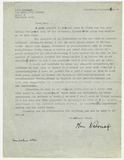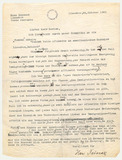Hans Natonek: Der Schlemihl (1936)
Hans Natonek: Der Schlemihl (1936)
Ihre Stärke ist der Alltag. Sie haben Sprache, wozu brauchen Sie das falsch Phantastische? Das ist etwas für Nichtskönner, die sich den „Stoff“ retten. Sie brauchen ja nur zu sehen.
[Your strength is the day-to-day. You have language, what do you need the false fantastic for? That's for bunglers who collect “material”. You just have to look. (ed. trans.)]
Joseph Roth to Hans Natonek, Paris, 17 May 1930
After the writer Hans Natonek had become stateless through denaturalisation and left only with his Jewish identity through the laws introduced by the Nazis, he grappled intensively with the meaning of identity. While still living in Germany, Natonek wrote the novel Der Schlemihl between early 1934 and autumn of the same year.
The basis of his historical novel is the biography of the writer Adelbert von Chamisso, who had lived in two countries – Germany and France – and attempted to unite the two within himself. He had not succeeded in this, however, as he had failed to find his place or a firm identity in either. Likewise, the narrator of Der Schlemihl examines questions of rootlessness and displacement. The central figure of the text is the outcast who, due to the loss of his livelihood and thus his identity, drifts restlessly through life. With the book, Natonek not only examines his own search for identity, but also foreshadows his own later experiences in exile.
Natonek wrote Der Schlemihl without the expectation that the novel would be published soon. But as early as 1935 (dated 1936 by the publishing house) – dedicated to the homeless of the world – the novel was published by Allert de Lange in Amsterdam. The Hameln-native exiled artist Léon Holmann designed the book cover.
Both works, Der Schlemihl and Geld regiert die Welt (1930), were later blacklisted by the Nazis.



